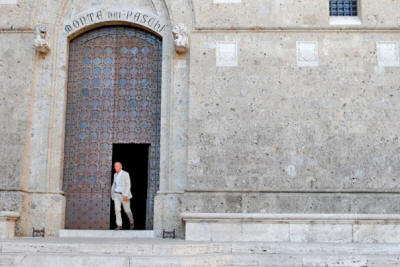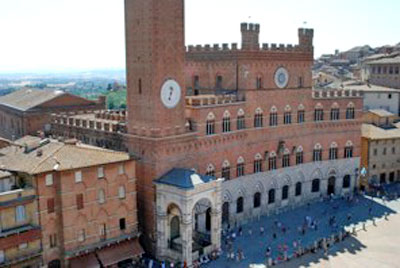
by Michael Birnbaum
September 1, 2012
from
WashingtonPost Website

SIENA, Italy
Tucked away in this Tuscan city, the oldest bank
in the world has survived the Borgias, pestilence and too many wars to
count.
Now, a mundane foe has proved far more dangerous:
Italian government
debt.
The 540-year-old
Monte dei Paschi Bank,
Italy’s third-largest, is on the ropes as it struggles to deal with holdings
of Italian bonds, once considered a prudent place to tuck cash.
The euro crisis upset that
calculation. Across Europe,
banks are confronting the same problem as seemingly
safe bets that governments would repay their debts
turned out to have been major gambles.
At the heart of the crisis, the tangled
relationship between governments and the financial sector amplifies the
financial problems on both sides. And in Siena, bountiful profits that
once poured from Monte dei Paschi’s treasure-filled Gothic palazzo have
dried up.
Last week, the bank announced that it had lost $2 billion in
the first half of 2012.
Analysts and the bank’s current management
say a long-prudent institution - based in the same building since 1472 -
got caught up in the froth of the cheap-credit years before the crash
and then made poor decisions about how to recover.
“It was really an orthodox and cautious
bank,” said Angelo Riccaboni, rector of the University of Siena,
which last year lost funding that would have come from bank profits.
In Siena, he said, “people are either
employees of the bank, or former employees of the bank, or would
like to be employees of the bank. The city and the bank are so
intertwined.”
Monte dei Paschi was lending money when
Christopher Columbus was still dreaming of the shortest route from home
to the shipyard, not India.

Siena, Italy’s main plaza.
The city is home to Monte dei
Paschi bank, the oldest in the world.
But the bank’s financial situation
deteriorated after it purchased a rival in 2007 in an ill-fated attempt
to expand its reach across all of Italy.
That decision resulted in
massive debts from which the bank is still struggling to recover. The
bank now appears to be the worst-off in Italy, with major capital
shortfalls and a plunging share price.
The 55,000 residents of Siena are looking at
the bank they call “Daddy Monte” with a newfound sense of vulnerability.
This year, Sienese owners were forced to give up their majority stake in
the bank, and many residents fear that the bank that has helped define
the city’s identity for more than five centuries will soon slip away
from them.
Profits from the bank financed the Palio, a
traditional horse race in the town’s austere center square. They paid
for renovations to the city’s severe Gothic buildings. They underwrote
biotech programs intended to turn the Tuscan plain into a research hub.
Nearly all that money - $150 million a year, on average, from 1996 to
2010 - has evaporated in the past two years.
“Nobody thought the banks would be in
crisis, and then nobody thought Monte Paschi would be in crisis,” said
Franco Ceccuzzi, the former mayor of Siena, who was forced to resign
this year after losing support over the handling of the city’s interest
in the bank’s management.
The bank’s troubles have caused soul-searching
among city residents, some of whom wonder whether the easy money blinded
them to problems as the crisis developed.
“When you have money, when it’s floating
around, nobody is as careful,” said Walter Bagni, 35, who works at a
major vaccine manufacturer that has a research center in Siena.
‘Not a prudent decision’
At the bank - which keeps watch over its assets
so carefully that a glass coffee table in a lavishly furnished waiting room
bears a tracking bar code - new managers say they have a plan to restore the
bank to profitability by 2015.
“The problem of Monte Paschi was the fact
that over the last two years, they invested a lot, in my opinion too
much, in the government portfolio,” Fabrizio Viola, chief executive of
Monte dei Paschi, said in an interview.
“It was not a prudent decision.”
But he said government bonds are a distinct type
of investment.
“It would be a completely different thing if
the bank issued loans to real estate and it caused a capital shortfall,”
he said, alluding to the property bubble that was a major factor in the
financial crises in Spain, Ireland and the United States.
Throughout the euro crisis, governments and
banks have had difficulty separating their fortunes.
Ireland’s government,
which had been careful with its spending before the crisis, had to resort to
a bailout after it took on the bad debts of its sizable banking sector.
The Spanish and Italian governments, meanwhile,
have found themselves at risk of needing bailouts as investors demand
significantly higher rates of interest to lend to them.
Higher rates have, in turn, added to the stress
on Monte dei Paschi’s finances, because it can sell only its holdings of
less-safe Italian bonds at a loss.
“If you’re concerned about the Italian
government, you’re going to be concerned about the Italian banks, too,”
said Ben May, an analyst at Capital Economics, a London-based research
firm.
“If you were going to see a fairly big
government default, you’d be wiping out a big chunk of Italian banking
capital.”
A range of
vulnerabilities
Attempts to help banks and to unfreeze European
credit markets have had mixed results, suggesting just how intractable the
problem is.
The European Central Bank initiated
an emergency program at the end of last year to give short-term credit
on generous terms to banks. That led to the banks’ buying even more
government bonds, further binding them to their governments.
The ECB has deemed long-term Italian government
bonds so risky that banks cannot use them as collateral when borrowing. As a
result, banks with large holdings of the bonds need to find other assets or
raise money to back basic operations. Monte dei Paschi appears poised to
give the Italian government an ownership stake in exchange for much-needed
cash to bolster its capital.
Analysts say some of Monte dei Paschi’s troubles
are unique.
Unlike with other banks, a Sienese foundation owned the majority
stake, and the foundation did everything it could to preserve local control.
When the going got rough, the foundation refused to dilute its stake by
issuing new shares to raise money, a stand that weakened the bank’s
finances.
The bank was also being managed, some analysts
say, by a parochial team whose members’ chief qualification was that they
were from Siena and who made decisions based on local political interests
rather than what was economically best for the bank.
“This is a problem with the governance of
Italian banks,” said Tito Boeri, an economist at Bocconi University in
Milan.
“But with Monte Paschi, it’s really an extreme case.”
“The foundation was doing whatever they
could to maintain this stake in the bank, and it’s obvious they
completely destroyed their asset,” he said.
Despite all the distress, some Siena residents
think the bank’s troubles will have a positive effect on the city’s life.
“Before, there was too much money given out,
forcing a laziness,” said Fabio Pacciani, a dentist who heads the
confederation of organizations that run the annual horse races.
“This
will force more collaboration, more volunteerism.”
Pacciani went on:
“All this well-being was being brought from
the bank. It brought a flattening of civic sense because there was so
much money.”


